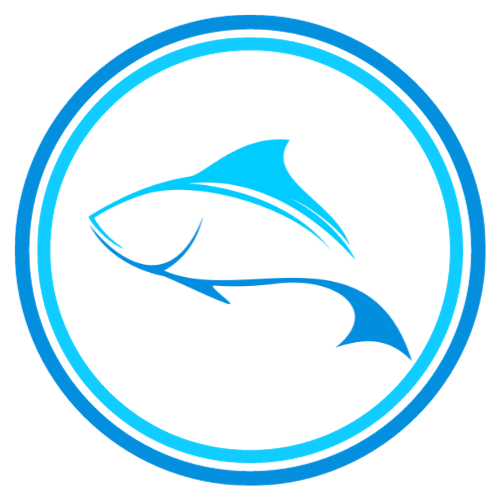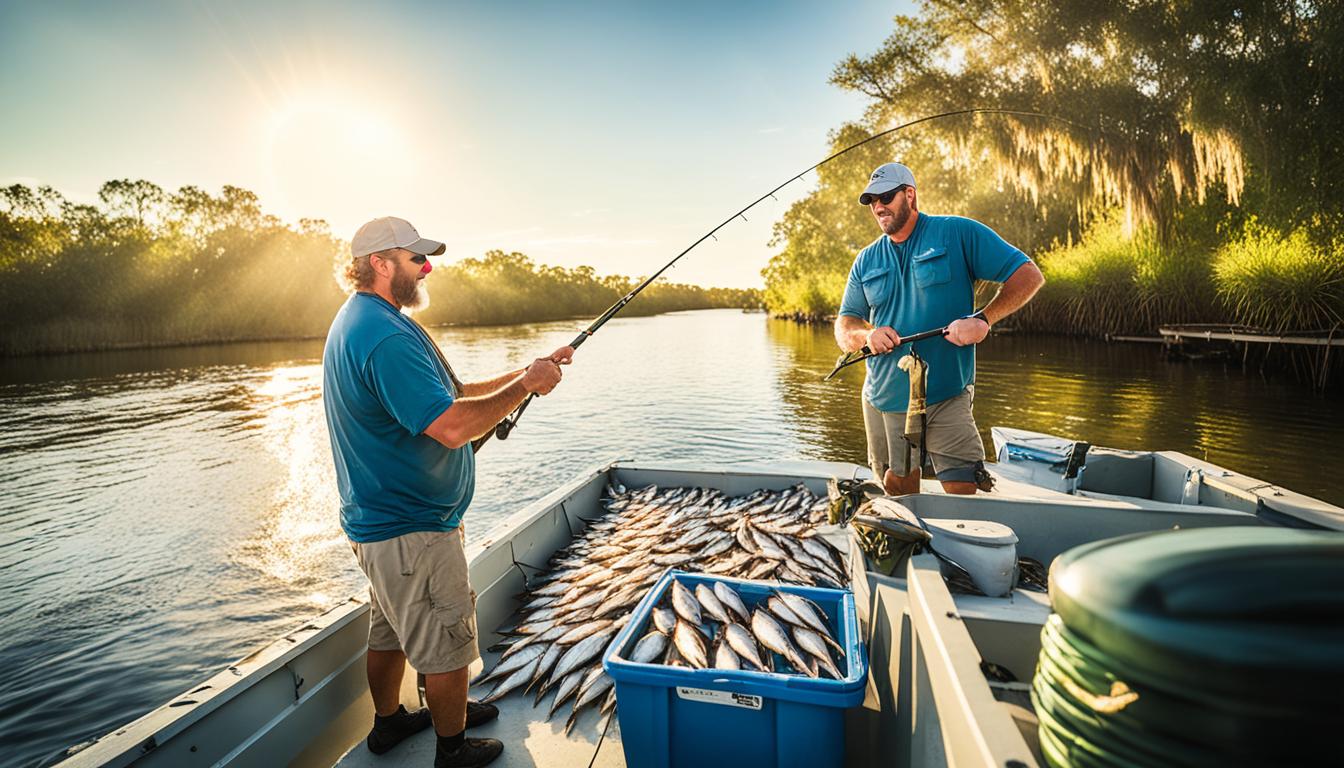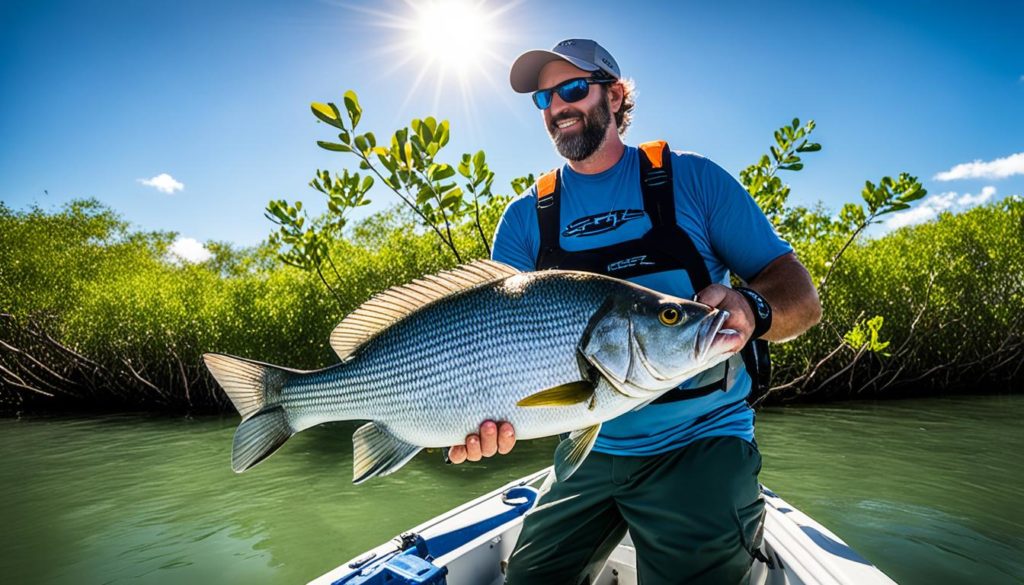If you’re an avid angler looking for a thrilling fishing experience in Florida, targeting sheepshead should be on your radar. These elusive fish are known for their challenging fight and exceptional taste, making them a popular catch among inshore fishermen.
Florida offers a diverse range of locations where you can find sheepshead, including underwater structures adorned with barnacles, grass flats, mangroves, oyster bars, and mangrove roots. The sheepshead’s small, sturdy mouth with buck teeth is perfectly evolved to pick barnacles off structures, and they are notorious for their ability to steal bait.
So, how can you successfully catch sheepshead in Florida? Let’s dive into expert tips and tactics to improve your chances of landing these elusive fish.
Key Takeaways:
- Sheepshead can be found in various locations in Florida, including underwater structures, grass flats, mangroves, oyster bars, and mangrove roots.
- The best bait for sheepshead includes shrimp, fiddler crabs, and oysters.
- Gently raising the rod tip and using smaller hooks can increase your success in hooking sheepshead.
- Florida has a strong sheepshead fishing season from December to March.
- Common gear for sheepshead fishing includes polarized sunglasses, UV performance fishing shirts, and 7′ medium action rods with 2500 or 3000 series reels.
Targeting Sheepshead around Bridge Pilings
When it comes to sheepshead fishing, targeting these elusive fish around bridge pilings can be incredibly fruitful. Bridge pilings often have barnacles attached to them, which sheepshead love to feed on. To attract these cunning fish, one technique is to scrape off the barnacles and create a chum slick in the water.
The best bait for sheepshead fishing around bridge pilings is shrimp. A small piece of shrimp on a #1/0 J hook, along with a split shot to add weight, is an effective setup. Downsizing hooks to 1/0 or smaller can also help minimize bait stealing by sheepshead.
If you’re wondering about bait choices, using frozen shrimp has proven to be successful when targeting sheepshead around bridge pilings. The scent and appearance of frozen shrimp can entice sheepshead to bite.
So next time you’re out on the water, don’t overlook the bridge pilings for sheepshead fishing. Scraping barnacles, downsizing hooks, and using frozen shrimp as bait can significantly increase your chances of landing a prized sheepshead.
Sheepshead Fishing in Inlets
When it comes to sheepshead fishing, inlets are another fruitful spot that anglers should explore. These natural entrances offer a wealth of opportunities to target this popular saltwater species. The boulders and sea walls near inlets provide the ideal habitat for sheepshead, as they are covered in barnacles, mussels, and oysters—their favorite delicacies.
To increase your chances of success in sheepshead fishing, try sight fishing by walking the rocks near inlets. Keep an eye out for these elusive fish and cast your line near the structure where they are likely to be feeding. Live shrimp and fiddler crabs are highly effective baits for enticing sheepshead in this environment. Remember to use stealth and patience to approach the rocks silently and make accurate casts.
If you’re looking to attract a larger school of sheepshead, consider chumming the area with small pieces of shrimp. This technique can create a feeding frenzy and draw more sheepshead to your fishing spot. Don’t be surprised if you find yourself catching snapper alongside sheepshead in inlets—they often share the same habitat and are attracted to similar baits.
Overall, sheepshead fishing in inlets is an exciting endeavor that offers the thrill of targeting these elusive fish in their natural habitat. Take advantage of the structure near inlets, use live shrimp or fiddler crabs as bait, and don’t forget to experiment with chumming techniques to maximize your chances of a successful fishing trip.
| Pros | Cons |
|---|---|
| Abundance of barnacles, mussels, and oysters in inlets attract sheepshead | Increased fishing pressure in popular inlet areas |
| Sight fishing opportunities in rocky areas near inlets | Requires stealth and patience to approach rocks |
| Live shrimp and fiddler crabs are effective baits | Snapper often compete for baits |
| Chumming can attract more sheepshead | May require trial and error to find the best fishing spot in the inlet |
Dock Fishing for Sheepshead
Dock fishing for sheepshead can be a rewarding and productive experience. Dock pilings covered in oysters, barnacles, and mussels provide the perfect habitat for sheepshead to thrive. When targeting these elusive fish at docks, there are a few key tactics that can maximize your chances of success.
Targeting Older Docks for Sheepshead
When choosing a dock to fish for sheepshead, it’s beneficial to target older docks. Older docks tend to have more marine life attached, including barnacles and oysters, which are preferred food sources for sheepshead. These docks provide more opportunities for sheepshead to feed and can greatly increase your chances of hooking them.
Best Bait for Sheepshead at Docks
Shrimp is the go-to bait for sheepshead at docks. Sheepshead have a strong affinity for shrimp and find them hard to resist. When presenting shrimp as bait, it’s important to use fresh or frozen shrimp. Freshly caught or store-bought shrimp will attract sheepshead with their enticing scent and natural appearance.
Downsizing Hooks for Sheepshead at Docks
Sheepshead are notorious bait stealers with their small, selective mouths. Downsizing hooks to a smaller size, such as #1 or #2, can help increase hook-up rates. Smaller hooks are easier for sheepshead to inhale, allowing them to fully swallow the bait before you set the hook.
Using Frozen Shrimp for Sheepshead at Docks
Using frozen shrimp for sheepshead at docks can be an effective strategy. Frozen shrimp have a longer shelf life and are readily available at bait and tackle shops. They can still attract sheepshead with their scent and texture, making them a convenient and practical choice for anglers.
Image Name: dock-fishing-sheepshead
Dock fishing for sheepshead offers a unique and exciting opportunity to catch these tasty and elusive fish. By targeting older docks, using the best bait, downsizing hooks, and utilizing frozen shrimp, you can increase your chances of success and have a rewarding fishing experience.
Understanding Sheepshead’s Bait-Stealing Behavior
Sheepshead are notorious for their tendency to steal bait, and understanding their unique anatomy can shed light on this behavior. These fish have small mouths and buck teeth that are perfectly evolved to pick off barnacles, mussels, and oysters from structures. Their strong jaws and sturdy teeth allow them to pry off these hard shells with ease.
One interesting adaptation that aids in their feeding habits is the presence of a pharyngeal plate in their mouths. This specialized structure is located in the throat and is designed to crush and grind shells, allowing sheepshead to extract the food inside.
To improve your chances of hooking a sheepshead and avoid falling victim to their bait-stealing antics, consider using a 1/0 circle hook. The design of this hook fits better in the sheepshead’s small mouth, increasing the likelihood of a secure hookset. Remember to be quick and confident when setting the hook once the sheepshead takes the bait.
In summary, sheepshead’s bait-stealing behavior can be attributed to their small mouth, sturdy teeth, and specialized pharyngeal plate. Using a 1/0 circle hook can help you overcome their bait-stealing tendencies and increase your chances of a successful catch. Understanding the intricacies of sheepshead’s feeding habits will undoubtedly contribute to a more productive fishing experience.
Sheepshead Fishing in Oyster Bars
Oyster bars and mud flats at low tide provide excellent opportunities for sheepshead fishing. These prime locations are known for their abundance of oyster clumps, which attract sheepshead looking to feed on shrimp and mud crabs.
One exciting method to catch sheepshead in oyster bars is sight fishing. By pitching shrimp or fiddler crab near the tails of sheepshead, anglers can entice these fish to strike. This thrilling approach is particularly enjoyable when using a fishing kayak, as it allows for stealthy maneuvering and the perfect position for accurate casting.
It’s worth noting that oyster bars in mangrove areas are also fantastic spots to target sheepshead. The combination of mangroves and oyster clumps creates an ideal feeding ground for these fish, increasing your chances of success.
Feeding Behavior of Sheepshead around Oyster Clumps
Sheepshead exhibit interesting feeding behavior when around oyster clumps. They will often tip and flip these clumps to uncover hidden prey, such as shrimp and mud crabs. This behavior creates an excellent opportunity for anglers to present their bait right in front of the sheepshead’s feeding path, increasing the likelihood of a strike.
By understanding sheepshead’s feeding behavior and using the right techniques, you can optimize your chances of landing a prized catch in oyster bars.
| Advantages of Sheepshead Fishing in Oyster Bars |
|---|
| Abundance of oyster clumps as feeding stations |
| Opportunity for sight fishing |
| Potential to target sheepshead in mangrove areas |
Exploring oyster bars during low tide and employing the right techniques can lead to a thrilling sheepshead fishing adventure. The combination of sight fishing, strategic bait presentation, and understanding sheepshead’s feeding behavior in oyster bars creates an exciting and rewarding experience for anglers.
Sheepshead Fishing in Mangroves
Mangroves provide an exceptional environment for sheepshead fishing. The intricate roots of mangrove trees are adorned with oysters and barnacles, creating the perfect habitat for these elusive fish. When targeting sheepshead in mangroves, it’s important to focus on their preferred feeding areas near the mangrove roots.
The tangled mangrove roots not only offer protection for sheepshead but also serve as a source of food. The oysters and barnacles attached to the roots attract sheepshead, making it an ideal spot to target them.
To increase your chances of success, using mangrove crabs as bait can be highly effective. Sheepshead find these crabs irresistible and are more likely to bite when presented with this natural delicacy.
When it comes to tackle, utilizing a 1/0 hook and split shot rig near the mangrove roots can entice sheepshead to take the bait. The 1/0 hook provides the perfect size and strength for hooking these sharp-toothed fish, while the added weight from the split shot ensures your bait remains within the strike zone.
It’s important to note that while targeting sheepshead in mangroves, you may also encounter mangrove snappers. These two species often share the same habitat and can provide an exciting mixed bag fishing experience.
Best Gear for Sheepshead Fishing
When targeting sheepshead, it’s important to have the right gear. Here are some essential items that will enhance your sheepshead fishing experience:
Polarized Sunglasses
Invest in a pair of polarized sunglasses for sheepshead fishing. These sunglasses help eliminate glare on the water’s surface, allowing you to spot sheepshead more easily. Polarized lenses also provide UV protection for your eyes.
UV Performance Fishing Shirts
Protect yourself from the sun’s harmful rays by wearing UV performance fishing shirts. These shirts offer sun protection and are made from moisture-wicking fabric to keep you cool and comfortable throughout your fishing trip.
7′ Medium Action Rod
A 7′ medium action rod is ideal for sheepshead fishing. It provides the right balance of sensitivity and power to detect subtle bites and handle the fight of a sheepshead. Look for a rod specifically designed for inshore fishing.
2500 or 3000 Series Reel
Pair your medium action rod with a 2500 or 3000 series reel for sheepshead fishing. These reels offer smooth drag systems and have enough line capacity to handle the runs and dives of a sheepshead. Look for reels with a high gear ratio for quicker line retrieval.
In addition to these key items, make sure to use 20-pound braided line, 1/0 or smaller hooks, and a 30-40 lb fluorocarbon leader for sheepshead fishing. Having the right gear will increase your chances of success and make your sheepshead fishing trips more enjoyable.
| Gear | Description |
|---|---|
| Polarized Sunglasses | Eliminates glare on the water’s surface, providing better visibility |
| UV Performance Fishing Shirts | Offers sun protection and moisture-wicking properties |
| 7′ Medium Action Rod | Provides sensitivity and power for sheepshead fishing |
| 2500 or 3000 Series Reel | Offers smooth drag and line capacity for sheepshead |
#include “Articles/common.py”
Expert Tips for Successful Sheepshead Fishing
When it comes to sheepshead fishing, patience is key. These elusive fish require a strategic approach and a bit of finesse to hook successfully. To improve your chances of a successful catch, consider the following expert tips:
1. Exercise Patience
Sheepshead are known for their picky feeding habits. It’s important to resist the urge to constantly jig or move your bait. Instead, allow your bait to sit and let the sheepshead come to you. This patient approach increases the likelihood of a bite.
2. Fish During Feeding Periods
Timing is crucial in sheepshead fishing. Target the fish during their peak feeding periods, which often occur in moving water and when the water temperature hovers around the 50s. These conditions make the sheepshead more active and eager to bite.
3. Use Freshly Shucked Oysters
Sheepshead have a discerning palate and can be quite selective in their choice of bait. For your best chances of enticing these picky eaters, try using freshly shucked oysters as bait. The strong scent and natural appeal of oysters can be irresistible to sheepshead.
4. Downsize Your Leader
Sheepshead can be finicky when it comes to biting. Consider downsizing your leader to a lighter 10-pound test to increase sensitivity and reduce visibility. This subtle adjustment can make a significant difference in hooking those elusive sheepshead.
Keep in mind that sheepshead fishing requires a combination of skill, knowledge, and a dash of luck. By following these expert tips and utilizing the right techniques, you’ll enhance your chances of a successful day on the water.
Conclusion
Sheepshead fishing in Florida is a thrilling and rewarding experience for inshore anglers. These popular and delicious catches can be found in various locations, including bridge pilings, inlets, oyster bars, and mangroves. Known for their challenging fight and excellent table quality, sheepshead provide an exciting challenge for fishermen.
However, cleaning sheepshead can be a bit tricky due to their bony structure. But the effort is well worth it, as these fish offer a flavorful meal that’s highly sought after. Their delicate, white flesh is perfect for grilling, baking, or frying, making them a favorite catch among seafood lovers.
My personal experience with sheepshead fishing goes back to my childhood. The excitement of reeling in these elusive fish, the anticipation of the fight, and the satisfaction of bringing home a delicious meal has kept me hooked on this sport for years. There’s nothing quite like the adrenaline rush when a sheepshead takes the bait and puts up a fierce battle.
In conclusion, sheepshead fishing is not only a challenging and thrilling activity, but it also offers the opportunity to enjoy a delectable seafood feast. Despite the challenges of cleaning these fish, their flavorful meat and the excitement of the catch make them a favorite among Florida anglers. So grab your gear, head out to the waters of Florida, and experience the joy of sheepshead fishing for yourself.
FAQ
How do I target sheepshead around bridge pilings?
To target sheepshead around bridge pilings, you can scrape off barnacles to create a chum slick. Use small pieces of shrimp with a #1/0 hook and a split shot. Downsizing hooks to 1/0 or smaller can also minimize bait stealing. Frozen shrimp is a popular bait choice in this situation.
Where can I find sheepshead inlets?
Inlets are a great spot for sheepshead fishing. Look for boulders and sea walls near inlets, which are covered in barnacles, mussels, and oysters that sheepshead love to eat. Sight fishing can be effective by walking the rocks and using shrimp or fiddler crabs. Chumming with small shrimp pieces can attract sheepshead. You may also catch mangrove snapper alongside sheepshead in inlets.
How can I fish for sheepshead at docks?
Dock pilings with oysters, barnacles, and mussels are popular spots for sheepshead. Choose older docks with more marine life attached for better fishing. Shrimp is the preferred bait at docks, although mangrove crabs and fiddler crabs can outperform shrimp near mangroves. Downsizing hooks and using frozen shrimp can be effective tactics for targeting sheepshead at docks.
Why do sheepshead steal bait?
Sheepshead have small mouths and sturdy teeth perfectly evolved for removing barnacles, mussels, and oysters from structures. Their teeth have a pharyngeal plate that evolved to crush hard shells. To minimize bait theft, using a 1/0 circle hook that fits better in their mouths can help. It’s also important to set the hook quickly once the sheepshead takes the bait.
Where can I go sheepshead fishing in oyster bars?
Oyster bars and mud flats at low tide are prime locations for sheepshead fishing. Sheepshead will tail and flip over oyster clumps to eat shrimp and mud crabs. Sight fishing for sheepshead by pitching shrimp or fiddler crab near their tails can be a fun method, especially when using a fishing kayak for stealth. Oyster bars in mangrove areas are also great spots to target sheepshead.
How can I fish for sheepshead in mangroves?
Mangroves offer an excellent habitat for sheepshead, with their roots covered in oysters and barnacles. Use mangrove crabs as bait and a 1/0 hook and split shot rig near the mangrove roots to entice sheepshead to bite. Mangrove snappers are often caught along with sheepshead in mangrove areas.
What gear do I need for sheepshead fishing?
When fishing for sheepshead, you’ll need polarized sunglasses for sight fishing and reducing glare, UV performance fishing shirts for sun protection and moisture-wicking, a 7′ medium action rod, and a 2500 or 3000 series reel. Other gear includes 20-pound braided line, 1/0 or smaller hooks, and a 30-40 lb fluorocarbon leader.
What are some expert tips for successful sheepshead fishing?
Patience is key when fishing for sheepshead. Letting the bait sit and not moving it too much can result in more catches. Fishing during feeding periods such as moving water and when the water temperature is in the 50s can enhance success. Freshly shucked oysters are preferred by picky sheepshead. Downsizing the leader to 10-pound and using smaller wire hooks are effective techniques for finicky sheepshead.
Why are sheepshead a popular catch in Florida?
Sheepshead are a popular and delicious catch among inshore fishermen in Florida. They can be found in various locations and are known for their challenging fight and excellent table quality. Cleaning sheepshead can be difficult due to their bony nature. Sheepshead fishing offers a rewarding experience filled with excitement and the chance to bring home a tasty meal.



